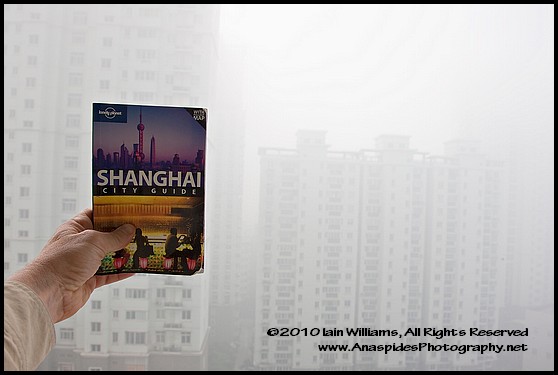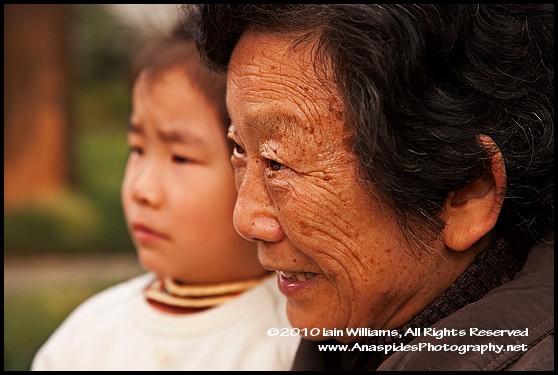 Due to other commitments, my stay in urban China was short, however, I did have three days to explore the metropolis of what has been called the most dramatic city in the world’s most changing nation. As indicated in an earlier post, Shanghai is a very cosmopolitan city that has developed into the epitome of western Chinese culture; Most of what is Shanghai is the biggest, the best and the brightest. To represent this a friend coined the term “bling”; Shanghai has bling everywhere.
Due to other commitments, my stay in urban China was short, however, I did have three days to explore the metropolis of what has been called the most dramatic city in the world’s most changing nation. As indicated in an earlier post, Shanghai is a very cosmopolitan city that has developed into the epitome of western Chinese culture; Most of what is Shanghai is the biggest, the best and the brightest. To represent this a friend coined the term “bling”; Shanghai has bling everywhere.
LEFT: My trusty Lonely Planet Guide which opens you to delites that Shanghai offers. This was taken from my apartment balcony and soon after you could not even see the buildings due to the pollution.
Christopher Isherwood in 1937 summered up Shanghai very well when he stated that “seen from the river, towering above their warships, the skyscrapers and impressive buildings of the Bund present, impressively, the façade of a great city. But it is only a façade”.
I discovered that much of what China shows the world is a façade.
 Main Shopping Area
Main Shopping Area
The main tourist/shopping region is as you would expect in any other major city; there are no surprises here. Large cement buildings stretch towards the sky whilst glass towers gleam in the sunlight. Advertising beckons to passing visitors to share their savings and purchase another unnecessary item to add to the growing collection of unessentials. It’s a fact that the people of Shanghai are renown China wide as the “shoppers of China”; they live to shop - and you can literally purchase whatever you want here (just make sure it’s real and not a reproduction).
Hawkers and Scams
You don’t have to wait long before hawkers single you out amongst a sea of black haired clone-like individuals in an attempt to sell you a reproduction Rolex watch, whilst in the more quiet areas of downtown, you maybe offered the services of a Chinese prostitute or be cajoled into speaking to a young Chinese girl wishing to practice her English.
LEFT: The ritz and glitz of Shanghai central. Fashion conscious Chinese stroll through the maon shopping district.
The way this scam works is that a young attractive Chinese girl will approach you and ask to practice her English. Most visitors will readily agree to this and before they know they are having an interesting conservation. The girl will ask if you may like to visit a local coffee shop, share a coffee or tea and talk more. Removed from the burden and boredom of work schedules most people agree. The idea is that the girl will have you taste a variety of teas and then, with the help of the store owner, attempt to sell you the tea at a very high price. Most smart travellers catch on very fast and make an exit, however, for the less initiated a large bill will await them before they can leave the premises.
 The Bund and Financial District
The Bund and Financial District
The Bund area of Shanghai is one of the major stopping off points for anyone in Shanghai. The bund was originally created to hold the banks of the meandering Yangze River at bay, and having accomplished this, has allowed development on both sides of the river. On one side of the river is the marvellous buildings constructed in the early 19th Century which depict Art Deco and Victorian architecture. These buildings tell of a time when Shanghai danced the tune to British colonialism and sovereignty and companies such as the Dutch East India Company were prominent in world markets and trade.
ABOVE: Night shot of the Shanghai Financial District. Note the thunderbird look-alike Oriental Pearl Tower. Obtaining a clean shot without a large freighter in the scene was difficult.
 On the far side of the river, which is connected by an underground tunnel sporting such bright lights that make Hollywood’s Star Gate pale into insignificance, is the major financial district of Shanghai. Here are constructed some of the tallest and oddest buildings on the planet. At night, they are lit in varying colours amidst laser lights and huge billboards (the size of a drive-in theatre screen) promoting “I love Shanghai and Samsung. Apart from the obvious glass towers and tall skyscrapers there is an assortment of oddities such as the Oriental Pearl Tower that looks more belonging to the Thunderbirds Are Go film set.
On the far side of the river, which is connected by an underground tunnel sporting such bright lights that make Hollywood’s Star Gate pale into insignificance, is the major financial district of Shanghai. Here are constructed some of the tallest and oddest buildings on the planet. At night, they are lit in varying colours amidst laser lights and huge billboards (the size of a drive-in theatre screen) promoting “I love Shanghai and Samsung. Apart from the obvious glass towers and tall skyscrapers there is an assortment of oddities such as the Oriental Pearl Tower that looks more belonging to the Thunderbirds Are Go film set.
LEFT: Accommodation blocks stand out in stark contrast against a yellow backdrop of aerial pollution.
Photographing the bund area is enjoyable – mainly because there are people everywhere; for the most part Chinese tourists on holiday in Shanghai! The city skyline is well worth the effort to see, provide visibility isn’t minimal due to aerial pollution. I was keen to take an elevator to the observation deck of one of the towers, but refrained from doing so when I noted that visibility was so poor that you could hardly see the top of the tower from ground level.
I was amazed to watch the volume and frequency of sea-going boats that traversed the Yangze River adjacent to the bund and city. There was never, in the 4 hours I was here, a break of more than 2 minutes without shipping! Everything from coal carrying tugs and barges, to military boats, police launches and massive cargo carrying ocean-going ships. It seemed as if the world was coming to Shanghai – in a boat!
 Pollution and Rubbish
Pollution and Rubbish
You cannot be at the centre of manufacturing, have a population of 25 million people, and have the largest growing economy on earth without pollution; that’s fact. The aerial pollution in my opinion wasn’t good, however, speaking with Chinese they claimed that the days I was in Shanghai the pollution was minimal. I learnt that China had closed many of the factories in the district in addition to minimising the number of vehicles entering the city to reduce aerial pollution whilst the China International Expo was being held.
According to Reuters, "During the Expo, the government was very conscious about our air quality and wanting to give foreign visitors a good impression," said Lisa Jin, a student at East China Normal University in Shanghai. "But after the Expo they have become lax and do not seem to care about the air quality."
LEFT: Motorcycles parked in front of accomodation blocks in Shanghai. Exhaust pollutants are a major cause of aerial pollution in the city.
I think I saw part blue sky once. For the most part it was as if I was walking in a yellow fog. Sadly, the Chinese do not seem to be too concerned with the pollutants entering the atmosphere, however, if China is to continue along the superpower highway then eventually, the authorities will need to address this ever-pressing question.
Paradoxically, I was very surprised that city streets and the Yangze River were clean of the normal rubbish too often observed in western cities. I don’t think I saw a cigarette butt and the volume of street litter (paper and bags) was very minimal. Watching the Yangze River flow along the edge of the Bund I was pleased to not to see very much floating rubbish. This is in contrast to other nations I have visited: Indonesia, parts of the Philippines and Tonga which had streets and land literally carpeted in day to day rubbish.
I have read that Shanghai recycles approximately 80% of it’s rubbish – no doubt this is what happens to the seemingly endless supply of plastic drinking water bottles. As to the water quality of the Yanze River, I would be foolhardy to comment, but I was informed that the tap water was not a beverage.
In my next post we’ll explore some of the dichotomies associated with Shanghai.
 Wednesday, December 22, 2010 at 9:37PM
Wednesday, December 22, 2010 at 9:37PM  I will end my story of my visit to China with an image I took at the People's Garden in Thames Town. It was of an old woman, the great grandmother of the young child. When she saw me she was reluctant to have her photograph taken, however, the young child was curious. The old lady beamed when she realized that I wanted to photograph the young girl, and it was at this stage they both relaxed.
I will end my story of my visit to China with an image I took at the People's Garden in Thames Town. It was of an old woman, the great grandmother of the young child. When she saw me she was reluctant to have her photograph taken, however, the young child was curious. The old lady beamed when she realized that I wanted to photograph the young girl, and it was at this stage they both relaxed. 














